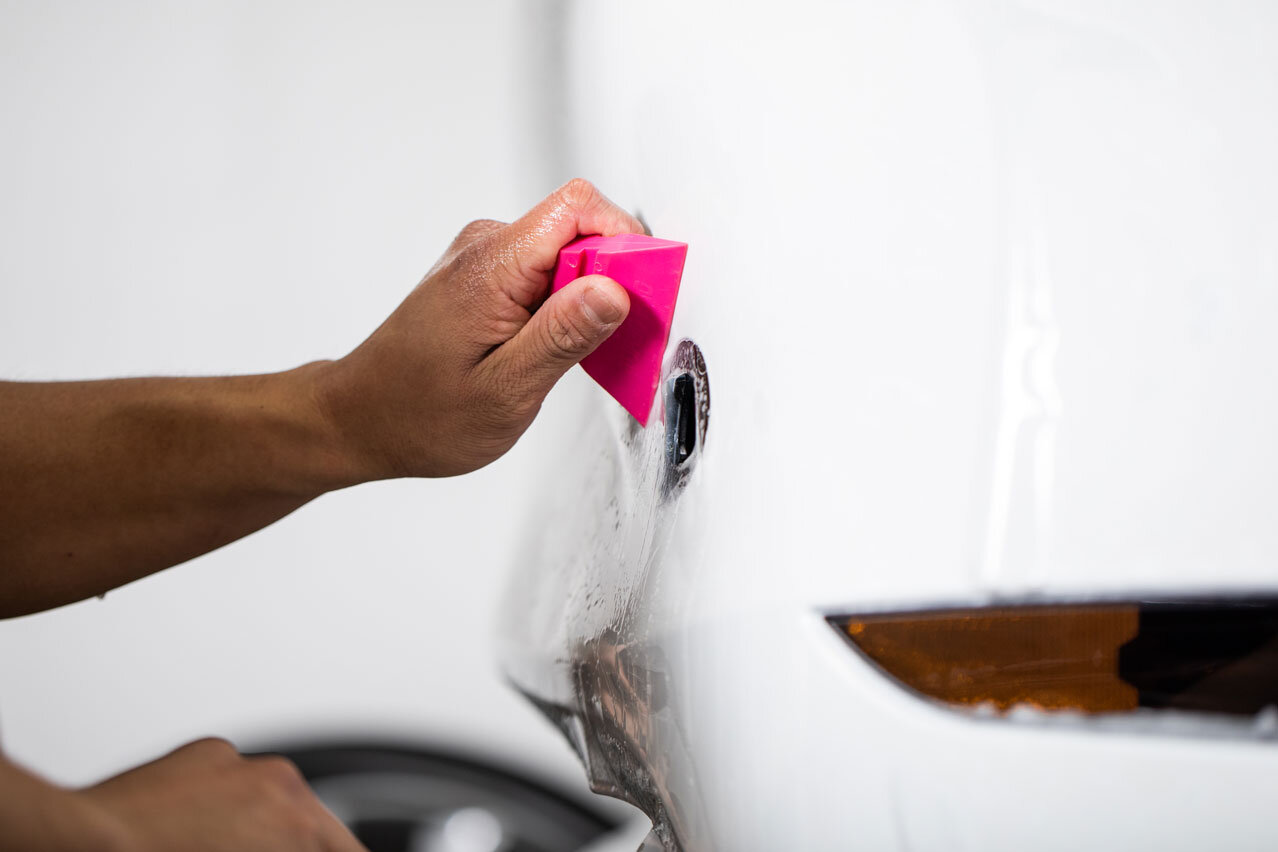What is PPF?
It’s a very strong and durable film made out of polyurethane, sandwiched in between a clear coat on top and an adhesive on the bottom. PPF is 3-11 mil thick – I know that’s a crazy range, but at the very least that’s 3x the thickness of colored vinyl. This is because its primary purpose is to protect.
Fun Fact: It was originally created to protect military helicopter blades, then it was brought to the commercial scene with Nascar, and now it’s made its way to the consumer market.
What are the benefits and features?
It protects your car from rock chips, scuffs, scratches, and the elements (bug acid, bird droppings, UV rays, etc.). It features self-healing abilities, making scratches disappear overtime with heat, a super glossy shine, and some even have hydrophobic properties, making it easier to clean. It also protects a painted surface against acid rain, mineral deposits, and water spots.
You can most commonly choose between matte or clear, but recently added to the PPF scene are colored and textured options. A popular customization option is tinted headlights, but typically, PPF is more of an invisible protection.
How is PPF installed?
PPF is a wet install. First you prep your vehicle by doing a deep decontamination and then paint correcting, making sure to get all the swirls out. Then, you spray a soap solution underneath the film, on top of the film, and on the car’s surface to allow the adhesive to slide and the squeegee to glide. It takes about 2-3 days to install a front package and up to 10 for a full car PPF. For removal, you’ll want to get it taken off professionally as not to take off the clear coating with it, but basically, you use steam and gently pull close to the surface.
How long does it last?
It lasts around 5-10 years, depending on how well it’s taken care of and how often it’s sitting in the elements vs a garage. Most higher quality brands have a 10 year warranty, and that includes from yellowing and cracking. Back in the day, PPF would crack and yellow easily, but that shouldn’t happen today. If it does, find another film.
What should I cover?
You can cover your entire car, however, I wouldn’t recommend it. It’ll be really expensive and excessive. The most important areas to cover are the front bumper, fenders, hood, headlights, and mirrors. This is called a front package. I would also recommend covering your rockers as the paint in these areas is very thin. These are the highest impact areas, meaning they get hit with bugs, rocks, and dings the most.
Even though in the name it says “paint protection,” it’s also for other areas such as your headlights and interior areas, like the glovebox, seatbacks, and door kickers. It’s installed just the same!
What’s the difference between bulk and template?
PPF is usually installed in bulk, meaning you install a large piece of PPF and then cut it precisely to make it fit. That requires a lot more skill and time than installing from a template. A template just means that it’s pre-cut with a computer. We actually use bulk and template depending on the area and what method is best.
My install doesn’t cover all the edges. Is that normal?
Yes. The parts of your car where the panels meet usually have PPF come right up to the edge but not over. This is to avoid it failing and peeling back. Most templated files are made to go up to the edges as well.
Can I do it myself?
The short answer is yes. It can take years to master the craft, but you can definitely do it yourself with our PPF kits that are pre-cut with easy to follow instructions. We have exterior and interior protection kits with the same quality that I use in my shop.
Can this be installed on any car?
It’s best to have a new or barely used car with minimal scratches and dings, but you can paint correct if needed. I would avoid putting on rusty or repainted cars unless you’re absolutely sure, because the paint and/or clear coat will peel off with the film when removed.
Note: PPF can go over vinyl wraps and under ceramic coating.
Recommended brands?
- 3M – Not as many options as some other popular brands.
- Avery – There are a few different options with Avery – gloss, matte, and a black called neo noir.
- XPEL – Most popular among the Tesla community.
- Stek – They have quite a bit to choose from, offering fashion PPF that can be colored or textured.
- Hexis
How much does it cost?
It depends on your location and complexity of install, but can be around $8,000 for a full PPF and $2,000 for a front package.




